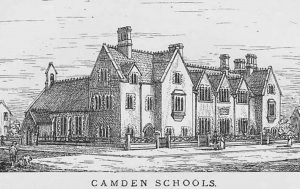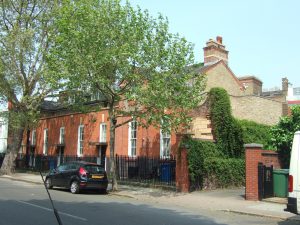NATIONAL SCHOOLS
Camden schools
The school commenced as a Sunday School only in 1800 with 15 boys and 15 girls. In 1813 the week-day schools were established.
A plain but roomy building, faced with stucco, and situate in Church-street, belongs to the Camden Chapel Sunday and week-day schools. The girls in this establishment are neatly clothed, but the boys wear a strange disguise, apparently invented when the argumentum ad baculinum was more frequently resorted to than at present. This institution was founded in 1800, and is supported by voluntary contributions.
Collections Illustrative of the Geology, History, Antiquities and Associations of Camberwell and the Neighbourhood Douglas Allport (1841)

Camden School, Sumner Road in the 1870s
In 1813 the week-day schools were established, when 30 boys and 30 girls were substantially clothed. The clothing has only recently been discontinued, as under the New Educational Code no grant is allowed for such a purpose. The original school buildings, which had from time to time been much improved by voluntary aid, were situated near the parish church, where Church Terrace now stands, until Christmas, 1847, when the schools were removed to their present site, Sumner Road, Peckham. The ” Camden District Schools ” were built under the auspices of the late Henry Kemble, Esq., M.P., who laid the foundation-stone on June 25th, 1846 ; and of the Rev. D. Moore and others, at an original cost of £3,500. Two class-rooms have since been added at a cost of £500, and a third one is in contemplation. There are at present about 1,000 children in attendance namely, 750 in the week- day schools, and the remainder Sunday scholars.
Ye Parish of Camerwell W.H. Blanch (1875)
Following the demolition of the church building in 1956, responsibility for the school was undertaken by the parish of St Luke, Peckham. It was renamed St Luke’s Primary School in 1979 and finally closed in the 1980s. The building still stands.
Peckham National Schools
The schools were started in 1813.
[They] were originally established in Victoria Place, on a piece of ground given by Augustus Hughes, Esq., of Peckham, for the term of 500 years, at the annual rent of a fat capon on the 4th September. The schools were subsequently removed to their present site, and the land in Victoria Place let on a ground-rent of 6 10s. per annum. The present site is freehold, and was purchased from Sir Edward Smijthe. The schools, which have been mainly supported by the members of St. Chrysostom’s Church, Hill Street, were closed for about ten years (1860-70). They were reopened on January 30th, 1871, free of debt, and are now in a highly satisfactory position. At the present time 304 children are on the books viz., 175 boys and 129 girls.
Ye Parish of Camerwell W.H. Blanch (1875)
St George’s National Schools
[These schools] were established in 1824, for the instruction of 250 children of both sexes. The unfitness of the building for the increasing work of the school was at once apparent to the present vicar on taking charge of the district, and soon after his appointment circumstances favoured the minister’s more enlarged and liberal views. In 1835 the late Mr. Joseph Ward left a legacy of 500 towards increased school accommodation ; and it is worthy of note that one of the chief sources of income to the schools at this period was a performance of sacred music in St. George’s Church, superintended by Mr. Adams, who presided at the organ. No less than £199 19s. 6d. was realized by this means in 1839. So well was the project of building the new schools received, that on the 28th October, 1839, the first stone was laid by Henry Kemble, Esq., M.P. for East Surrey, and on the 2nd July, 1840, the buildings were formally opened. The designs were supplied by Mr. W. G. Colman, and the cost, which was mainly defrayed by voluntary contributions, exceeded 3,000. Not only is the new school admirably adapted for educational purposes, but it also serves as a lecture hall, accommodating upwards of 700 people.
On a site adjoining, a very good infant school has been lately erected, entirely at the cost of one family, as a filial tribute to the memory of John Syer Bristowe, Esq., an old and highly respected inhabitant of the parish, and an attached member of St. George’s Church.
Ye Parish of Camerwell W.H. Blanch (1875)
School website today: St George’s Church of England Primary School
East Dulwich National Schools
The first school known to be established in Peckham Rye was an infants’ school attached to the East Dulwich Chapel in 1827. Peckham Rye National School was built in Troy Town 1839.
Are situate on Peckham Rye, and have not long been opened. The building is cheerful and airy, and the number of children at present under instruction proportionate to the zeal with which the neighbourhood has been canvassed. These schools are considered to be immediately connected with the chapel on Rye-green.
Collections Illustrative of the Geology, History, Antiquities and Associations of Camberwell and the Neighbourhood Douglas Allport (1841)
As the population in this area grew, larger premises were needed for both church and school. St John the Evangelist Church on Goose Green was consecrated in 1865. After further fund-raising, a new school was constructed in 1872 at the corner of Archdale Road and Northcross Road amongst the growing suburbs of East Dulwich.
The school buildings were extended in 1901 and 1965; Epiphany Hall, Bassano Street, and Thomas More Hall in Lordship Lane were used for additional classroom space.
In 1994 St John’s & St Clement’s school moved into the former Adys Road Board School building. The old school, ‘St Clement’s Yard’, was converted into flats.
School website today: St John’s and St Clement’s Church of England Primary School
Christ Church National Schools
Opened 1841. Christ Church started an infants school in Arthur Street (now the Ledbury Estate) that eventually grew into the modern-day Camelot School. It ran another infant school on the site of the present vicarage in Asylum Road.

Christ Church National School, Asylum Road
A building is now erecting in Asylum-road, Old Kent-road, for the National, Infant, and Sunday schools of Christ Church district. They are intended for the education of four hundred children in the principles of the Established Church. The site has been given by Sir Edward Bowyer Smyth, to whose praiseworthy zeal for the well-being of the parish we have more than once alluded. The worthy baronet has also contributed largely to the building fund, and has become a liberal annual subscriber to the institution. The excellent bishop of Winchester has also lent his aid, by preaching in its behalf ; and the ladies of Camberwell, ever forward in the cause of charity, have very considerably augmented its funds by a fancy sale, on a scale of unusual splendour, at the Grove-house.
Collections Illustrative of the Geology, History, Antiquities and Associations of Camberwell and the Neighbourhood Douglas Allport (1841)
Asylum Road School was transferred to the London School Board in 1887-8. Eventually the old school building was converted to housing.
St Mary Magdalene Peckham National School
Schools were built in this parish in 1856, at a cost of £1,260. . . There is a National school in the Albert Road in connection with this church, with accommodation for 130 boys, 120 girls, and 150 infants.
Ye Parish of Camerwell W.H. Blanch (1875)
St Mary Magdalene new school opened March 2001 and the old buildings were converted to housing.
School website today: St Mary Magdalene Church of England Primary School
BRITISH SCHOOLS
Peckham Lancasterian School
Originally founded in 1812 by Harrv Newman, Esq., and other members of the Society of Friends, in a building the site of which is now occupied by the Hill Street Brewery. In 1822 the school was removed to the present building, and was conducted on the Lancasterian principle, the master being the late Mr. Thomas Weston, who resigned his duties in 1859, after forty-seven years’ labour. The school, which was closed for a short time after Mr. Weston’ s retirement, was reopened in 1860, on the British and Foreign Society’s system, the present master, Mr. Balchin, commencing his duties on April 30th, 1860. Mr. Ballantine has since been appointed assistant-master. The average attendance is 180. The Peckham Theatre formerly occupied the site of this school, and was open nightly during part of the year, under the management of the celebrated Penley family.
Ye Parish of Camerwell W.H. Blanch (1875)
Kent Road British Schools, Oakley Place
Established in 1845, mainly by the exertions of Henry Richard, Esq., the present Member for Merthyr Tydvil. The portion occupied by the boys consists of one large room, 51 ft. by 31 ft., and three smaller class-rooms, added in Midsummer last. The girls’ rooms consist of one room, 36 ft. by 30 ft, one class-room, 20ft. by 15 ft., and smaller class-rooms, also added at Midsummer last. The average attendance of boys in 1873 was 170, and of girls 176. There is a large playground in the rear of the school buildings. The members of the committee are nearly all connected with the Marlborough Chapel, Old Kent Road. Mr. W. Eckensall is the master and Mrs. A. E. Parish the mistress of the school.
Ye Parish of Camerwell W.H. Blanch (1875)
On being superseded by the London School Board the building was sold, and the price, according to the Trust Deed, paid to the British and Foreign School Society.
WESLEYAN SCHOOLS
Stafford Street Schools
A new Wesleyan chapel was opened in Stafford Street on 26 December 1833. As the population grew, it became too small so a new church was built in Queen’s Road in 1865. The old church was then used as a Wesleyan school until it was sold to UGS (The Peckham Settlement) in 1929.
ROMAN CATHOLIC
St Francis School, Lower Park Road / Friary Road
A small Roman Catholic chapel and school were erected in Peckham Park Road in 1855.
There are two schools one for girls, and the other for boys, both under Government inspection. There are about 150 attendants in the former and 130 in the latter ; both schools have obtained excellent reports from the Government inspectors. The Roman Catholic district of Peckham contains about 3,000 Catholics. Since the formation of this mission, great educational and social progress has been made in the neighbourhood, very much having been done to improve the moral and physical condition of the poor. The Franciscan Order is one of the most remarkable and numerous in the Church of Rome. . . The Rev. Father Emidius, Superior of the Capuchin Community of Our Lady of Dolors, has been connected with the church since its establishment in Peckham. He is Italian by birth, and not long since became a naturalized British subject. He is much beloved not only by members of his own flock, but by Protestants of every denomination.
Ye Parish of Camerwell W.H. Blanch (1875)
School website today: St Francis Catholic Primary School


